You Can Make Anything Sad by Spencer Madsen
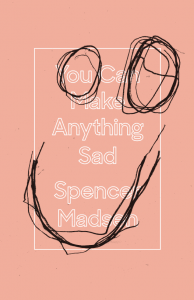 You Can Make Anything Sad
You Can Make Anything Sad
by Spencer Madsen
Publishing Genius, April 2014
90 pages / $10 Preorder from Publishing Genius
Spencer Madsen’s latest book, You Can Make Anything Sad, seems to be a response to a question Spencer asks himself within the poems he writes: Who am I and what am I doing? The poems constantly shift in image, but seem to stay in a general area of themes and moods. He plays with his voice, and style, to create something that feels very much completed, while at the same time quite fragile and open. It’s sincerely insincere, approaching the mundane as if it was wondrous, and the wondrous as if it was mundane.
I move back to Facebook, I type:
If you feel an aversion to me and I don’t feel an aversion to
you, please don’t feel an aversion to me.
I think about how my parents had hoped for more.
I think about letting them down constantly.
I think, at least I’m not a murderer.
Mostly because murderers are very ambitious.
April 21st, 2014 / 10:00 am
Actors Anonymous by James Franco
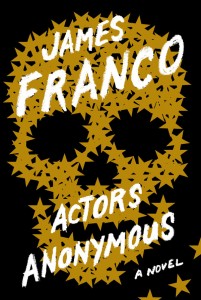 Actors Anonymous
Actors Anonymous
by James Franco
Little A / New Harvest, Oct 2013
304 pages / $26 Buy from Amazon
James Franco seems to want to be anything he can think of. He is an actor-writer-director-producer-musician-artist, as well as a PHD candidate. This novel, Actors Anonymous, suffers from the same desires that the author does; it wants to be every kind of novel it can think of. The novel-group of stories-abstract meta sentences is arranged in a sort of alcoholics anonymous style, with twelve chapters apparently representing the twelve steps.
March 21st, 2014 / 11:00 am
The Best American Comics 2013
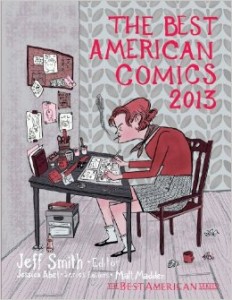 The Best American Comics 2013
The Best American Comics 2013
Edited by Jeff Smith
Series Edited by Jessical Abel & Matt Madden
Houghton Mifflin Harcourt, Oct 2013
400 pages / $25 Buy from Amazon or Houghton Mifflin Harcourt
The Best American Comics series is an anthology of comics, published annually with numerous guest editors, showcase what the editors feel are the best comics of the year. This edition contains thirty comics; some of them being complete, and others excerpts from larger comics. What is also nice to see is the vast majority of webcomics that are included in this edition, such as Kate Beaton’s tumblr famous ‘Hark A Vagrant!’ series. And although different, these comics all seem to share something in common, something ethereal that seems to connect these pieces all together that I can’t quite put my finger on, and I am glad that I have trouble doing this.
One of the things that I think brings the comics together is the feelings of anxiety that the characters seem to have. As I was reading the collection, I couldn’t help but think that they all seemed to be looking for something; in Alison Bechdel’s Mirror, the protagonist is searching for not just her own identity, but also seems to be searching not just for her mothers approval and love, but for her mothers identity, as well as trying to find her own place in the world. I think that the search for purpose and identity, although not just central now, as It has been a common problem for centuries, speaks to a generation raised in the internet age, one that has tried to find a personal identity through the lives of millions online.

In You Lied To Us!, by Jorge Aquirre and Rafael Rosado, the protagonist, a little girl, lies to her friends in order to look for, and slay, a local giant. Here, the protagonist is trying to create her identity through tackling the giant on her own, but in confidence is scared and alone. I think that this narrative, the David and Goliath story, echoes throughout a lot of us in our modern day lives; we want to tackle giants on our own, but we are too afraid and lack the skills to do it, and asking for help can make one appear weak. Although, like the previous comic, this is not a new narrative, I do feel that this story seems to hit at the centre of our shared anxieties. We live in a world of self made millionaires, twenty somethings who changed the world, who appeared to do it on their own, indadvertedly causing an entire generation to feel like they have to go it alone as well

Faith Erin Hicks Raiders also talks about individualism, but does so in a different way. The protagonist retrieves what appears to be an artifact of some kind, to return to a ghost seeking some sort of atonement. She does this with the help of her friends at first, but decides to sneak of an seek out the ghost alone, thinking that her friends will think less of her. It appears, despite not finding atonement through the ghost, that her friends also see the ghost, which gives to her a different kind of atonement, causing the ghost to leave. I feel that this seeks to tell us that going it alone is intact damaging, showing one that we all have hidden doubts and fears, here symbolized by the ghost, and sharing these fears and doubts is healthy, and one can overcome the giant, or the ghost, by reaching out to those around you.

What is also interesting to note is how different each piece is from another aesthetically. Each comic in this anthology is distinctly unique in its artwork, ranging from the almost life like, which can be seen in Mirror, to the surreal and weird. Some comics are full of texts, others nothing but a series of images. What is fascinating to note is that they are all able to tell a story, regardless of the way they do so, full of as much power, emotion, and expertise as one would find in a more ‘traditional‘ piece of fiction, such as a novel.
In editing the anthology, the editors seem to be aware of the problems the artists are trinyg to tackle, subconsciously or actively, and are seeking to address these problems through the anthology. What is clever about the addition of the webcomics is that a lot of these problems, of identity and feeling isolated, are ironically magnified by our existence in an online world, but can also be cured by our participation in the same world. One can construct our identities through others; our mothers, stories of great people, our friends, but we aren’t really able to overcome these anxieties and self doubt until we try to identify with ourselves, by confronting our doubts, opening up to our community, and just being ourselves. I feel that this is one of the central messages of this anthology; a reflection on the way we interact and inhabit the world has so drastically changed that we haven’t had the time to catch up to it yet.
***
Rhys Nixon is a writer who lives in Australia. He has been published in electric cereal, Gesture magazine, and posts occasionally on his blog, rhysrhys.tumblr.com.
January 17th, 2014 / 10:00 am
News Of The Haircut by Peter Bergoef
 News Of The Haircut
News Of The Haircut
by Peter Bergoef
Greying Ghost Press, Originally published 2007 / Republished 2013 as part of Greying Ghost Archive Series (#1)
$5 / Buy from Greying Ghost Press
News of the Haircut is a chapbook by writer Peter Bergoef, published by Greying Ghost Press, as part of their Archive series. First published in 2007, this chapbook seems to touch on themes, such as love, loss, sadness, and the all too common feelings that are often described as an existential crisis, explored via a vague narrator like approach, giving the poems a somewhat personal feeling to them. These poems, which appear abstract at first, give the reader a series of images within images, presenting a version of themselves within the pages that one all too often tries to ignore.
other victims running their mouths
transmitting maths
through satellites
news of the haircut
the impending registration
over a few drinks served
What I notice here is an idea of a shared helplessness, which is shared through our connection and inhabitance of the internet. Transmitting maths through satellites, victims running their mouths, and being handcuffed to the chair, all give one the image of people who both need the internet, whether they want to admit it or not, and are afraid of their reliance on the internet. This seems to be a common theme among writers who interact with the online world, like Heiko Julien, Megan Boyle, or Tao Lin, writers who have become identified through the internet, and have also talked about loneliness and isolation through this medium. These writers seem to all depend on, and are sometimes repulsed by, the life led online, which reveals itself through their writing through the use of concrete and stark imagery. I think this is, in a way, become a reimagining of what existentialism posits, that life is absurd and meaningless, and that the only way for one to ‘break free’ from this crisis is to accept that life is absurd. So possibly, the contradiction of living ‘irl’ online is the absurdity that these writers are trying to accept.
and forceps have in common
so much cream colored wallpaper
so many dull rooms
Here he uses the images of birth, and the image of a straightjacket, implying being locked away in an asylum of sorts, to create an interesting juxtaposition between what “normal” is, and how one persons normal can be another’s “crazy.” The use of all lower caps is interesting as well, as it gives the poems a passive voice, sharing with the reader a feeling of hopelessness that comes from the non direct quality of the lines. In effect, the messages are both passive and active in the way they are structured and interpreted, which I find very interesting in all of the pieces.
Bergoef’s central theme, however, seems to be one of helplessness, or loneliness, and is again shown in the poem Awake. The use of short, simple lines, combined again with the lack of capitalization, combines to create an image that I can only describe as being “depressing,” but still not an unknowable image.
shallow breath
through a dim room
what was destroyed during sleep
now waits in the corner
forget dreams
eat cereal cold
take in coffee hot
souring the mouth
December 23rd, 2013 / 12:00 pm
I Am Ready To Die A Violent Death by Heiko Julien
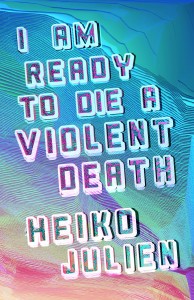 I Am Ready To Die A Violent Death
I Am Ready To Die A Violent Death
by Heiko Julien
Civil Coping Mechanisms, Nov 2013
Book Page at CCM
In I Am Ready To Die A Violent Death, Heiko Julien presents to us a kaleidoscope of images, ranging from the suburban, to pop culture references, memes, and the internet, presented through a meditative narrator questioning everything they see, while at the same time doubting what they are saying. Ironically the writing is both positive and self-deprecating at the same time, mirroring the multi-faceted life we inhabit online through different personas; we are both the nice, tolerant and compassionate person, and we also want to die a violent death, alone, so we can feel something that is real in a physical sense, not just through social networking.
What strikes me first of is that these pieces began as either self-published e-books, Tweets, or Facebook posts. This way of sharing ‘content’ online seems to be central to ‘Alt lit.’ Heiko has already begun a dialogue with his audience before the book has been published; I had read most of these pieces online before coming to read this book. This is quite a unique trend that is happening in the publishing world; there isn’t one way of ‘being a writer.’ And the idea of publishing itself has become quite flexible. I feel that Heiko is aware of this, and the writing in this collection reflects the continued dialogue he has with the Alt Lit community, which he seems to be a major part of.
“Facebook is the void that talks back.” (facebook post)
Heiko is well aware of the power of memes, in a similar way Steve Roggenbuck talks about the memeplex, which he defines as “a grouping of associated memes that are consistent and which support each other.” And that a “meme” is a unit of culture and/or anything that is spread by imitation (stylistic moves included). Heiko also uses the language of memes to project this view; via different forms of online language, be it advertising, tweets, Facebook, or blog posts.
I am afraid of men but I am a smart boy so i intellectualize my fear in the form of Cool Shaming and Tight Blaming. If I’m being honest, I would like to be the Number One Dude. I admire strong guys. I like to watch them play sports. I relate to the idea of a Buff Bro. I like a dude so top heavy I can topple him with a good push. I like to push dudes into pools in the summertime.
For Heiko, as well as others in the online community, memes also constructed through online ‘brands’ or ‘personas’, where ones identity becomes a meme. This feels like one of the central themes to not just Heiko’s writing, but to the ‘genre’ of Alt Lit. What makes Alt Lit a unique genre, however, is that it feeds into the aspects of an online community members and environment which Heiko references a lot in his writing, and the online community all construct different personas, or identities, through different social media outlets. In this way, Heikos writing puts a mirror up not just to himself, but the community he responds to. The writing does not just reflect the community that is Alt Lit, however, it also stems from something else, something more ‘human,’ or ‘natural‘, whatever that may mean in the ‘internet age‘ that we all live in. Social stereotypes become crystalized through online media, which in turn become memes, and a part of the online language that Heiko channels in his pieces.
But I guess what I most want is to be in actual love with a woman who actually loves me back until we die painless, unexpected deaths simultaneously, but someone told me this was already done in a Bad Movie.
There is a strong sense of irony in these pieces, that the only meaningful things that can be said have already been said through media, and that is all the narrator knows. Memes have become our ‘language,’ our way of communicating in our ‘environment,’ and these pieces show the point of where a meme stops and the human being typing them begins. The writing is a projection of the narrator’s own inner dialogue, while at the same time being mixed in with memes and other online jokes. In this way, we are constantly reminded that there is a person behind the writing, a person who has their own desires, goals, and emotions.
and we are dancing
like we know people
Out There
want to take our money
and kill us
and we still think they are beautiful
Notice how “Out There” has been capitalized, this “other” could possibly mean something like a world free from online content, something more ’real’, but the narrator, by calling it the other, has no idea what this could be. In doing so, we are shown a crisis the narrator is having, and one that we are all aware of; all we are becoming aware of is our online presence, then what is our ‘real’ identity?
You can see a lot of Rare Vids of Young Dudes hanging out at home and doing funny voices if you search Just Chillin on YouTube. Go ahead and try this and maybe then you will learn how to love without needing to receive anything in return.
November 8th, 2013 / 11:00 am
Diadem: Selected Poems by Marosa di Giorgio
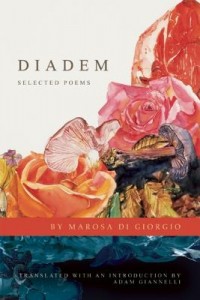 Diadem: Selected Poems
Diadem: Selected Poems
by Marosa di Giorgio
Translated by Adam Giannelli
BOA Editions, Oct 2012
80 pages / $16 Buy from BOA Editions or Amazon
In Diadem, Di Giorgio’s prose-styled poems are a collage of images ranging from the surreal to the innocent and childlike. Shadows stalking about the farm house amongst rose gardens, God appearing as a face and speaking, and children performing plays in the garden. Giorgio speaks to us through these images, playing with them, distorting them, and living in them; she speaks of “The owls, with their dark overcoats, thick spectacles, and strange little bells”, and “Virgin Mary, enormous wing over my whole childhood and the whole countryside.” These images, contrasted with the speech-like prose style, paints surrealistic and beautiful pictures of culture, childhood, sexuality, and death.
“God’s here.
God speaks.”
As noted by the translator of the collection of poems, Adam Giannelli, these poems could be read as a novel, cover to cover, or on their own as individual pieces, and they would still have the same power and depth. The poems themselves blend and blur the lines between each other, in effect recreating an idea of recalling memories of the past; sometimes fantasy, sometimes all too real, and always fleeting and hard to properly pin down.
The poems themselves are often quick to change in subject matter and mood; often these poems begin with something childlike, like a story or a memory.
“We would put on plays in the gardens, at twilight, beside the cedar and carob trees; the show was improvised on the spot, and I was always afraid I wouldn’t know what to say, although that never happened.”
The poems often quickly turn, however, such as in this fragment. What is meant by a play is quickly distorted into something else; be it the anxieties of adolescence, maturation, or something more so. What makes these pieces stand out is that sometimes it is hard to know exactly what is happening, but it doesn’t take anything away from it.
“The mushrooms are born in silence; some are born in silence; others, with a brief shriek, a bit of thunder.”
The flexibility Di Giorgio employs with image, as well as grammatical constraints, helps give the pieces a somewhat corporeal feel; there is some sort of otherness to them.
“Each ones bears-and this is the horrible part-the initials of the dead person from which it springs.”
The themes turn so quickly that the reader almost can’t keep up. First one has this image of a mushroom growing in the ground, but being born of thunder turns the poem; why would there be thunder? And then, the initials of the dead are introduced, so perhaps these are supposed to symbolize some sort of cultural thing; death and rebirth. However, the piece makes another turn in the very next line.
“But in the afternoon the mushroom buyer comes and starts to pick them. My mother lets him. He chooses like an eagle. That one, white as sugar, pink one, grey one.”
Here now the subject has changed again; perhaps the mushroom buyer is reaping the spoils of war? Perhaps this is westernization? Maybe they are just regular mushrooms? It is these parallels of images working together, juxtaposing themselves rapidly and fluidly, which creates powerful pieces of poetry all under a single breath.
October 25th, 2013 / 11:00 am
